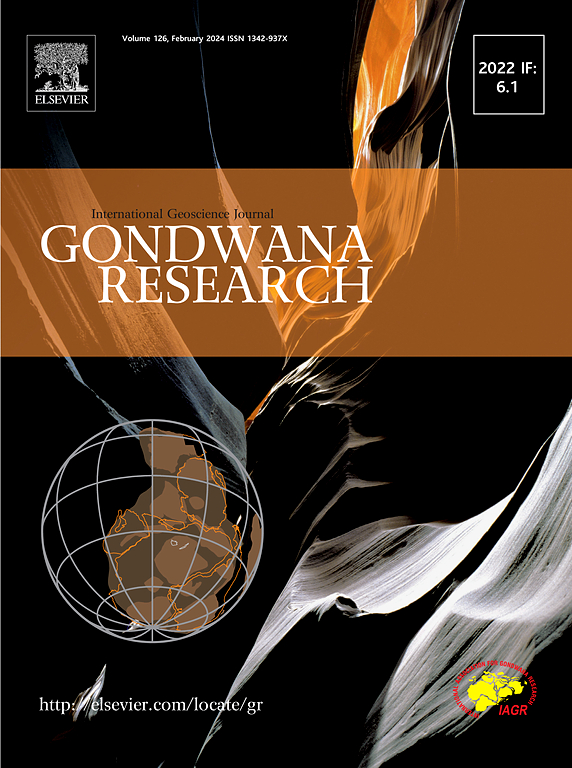三维重力反演揭示藏北深层岩石圈东西不对称性
IF 7.2
1区 地球科学
Q1 GEOSCIENCES, MULTIDISCIPLINARY
引用次数: 0
摘要
青藏高原是新生代印度板块与亚洲板块碰撞形成的,中新世中期以来,青藏高原地表地形不对称,地壳变形和岩浆活动呈东西走向。然而,通过岩石圈变形控制高原隆升的机制尚不清楚。本文提出了一种新的岩石圈密度模型,该模型是由层析模型约束的三维重力反演得到的。结果表明,金沙缝合线(34-35°N)附近岩石圈地幔密度结构具有明显的东西变化特征。以89°E为分界线,西段(83 ~ 89°E)深度在~ 100 km以下表现出明显的低密度异常(小于- 0.1 g/cm3),这可能是由于下岩石圈的移除和软流圈物质上涌所致。东部(89 ~ 95°E),从Moho到深度~ 160 km,呈现向南倾斜的高密度异常(~ 0.05 g/cm3),这可能反映了亚洲岩石圈地幔在西藏下方的俯冲作用。综上所述,藏北深层岩石圈的变形在东西方向上呈现不对称特征。在西部,岩石圈根部的丧失可能导致高原的快速隆升和火山活动。在东部,陆内俯冲伴随着大型走滑断裂的活化和相关地体的东挤压。本文章由计算机程序翻译,如有差异,请以英文原文为准。
East-west asymmetry of the deep lithosphere beneath northern Tibet revealed by a 3D gravity inversion
The Tibetan Plateau, formed by the collision between the Indian and Asian plates during Cenozoic, exhibits asymmetric surface topography, crustal deformation, and magmatic activity since the Middle Miocene in the east–west direction. However, the mechanism controlling the uplift of plateau through lithospheric deformation remains unclear. This study proposes a new lithospheric density model obtained by a 3D gravity inversion constrained by a tomography model. The results reveal a significant east–west variation in the density structure of the lithospheric mantle beneath the vicinity of the Jinsha suture (34–35°N). Taking 89°E as the dividing line, the western region (83–89°E), at depth below ∼ 100 km, exhibits an obvious low-density anomaly (less than −0.1 g/cm3), which may be caused by the removal of lower lithosphere and upwelling of asthenosphere material. In contrast, the eastern part (89–95°E), from Moho to depth of ∼ 160 km, shows a high-density anomaly (∼0.05 g/cm3) dipping to the south, which may reflect the subduction of the Asian lithospheric mantle beneath Tibet. In summary, the deformation of the deep lithosphere beneath northern Tibet exhibits asymmetric features in the east–west direction. In the west, the loss of the lithospheric root may lead to rapid uplift of the plateau and volcanic activity. In the east, intracontinental subduction is accompanied by the activation of large strike-slip faults and the eastward extrusion of related terranes.
求助全文
通过发布文献求助,成功后即可免费获取论文全文。
去求助
来源期刊

Gondwana Research
地学-地球科学综合
CiteScore
12.90
自引率
6.60%
发文量
298
审稿时长
65 days
期刊介绍:
Gondwana Research (GR) is an International Journal aimed to promote high quality research publications on all topics related to solid Earth, particularly with reference to the origin and evolution of continents, continental assemblies and their resources. GR is an "all earth science" journal with no restrictions on geological time, terrane or theme and covers a wide spectrum of topics in geosciences such as geology, geomorphology, palaeontology, structure, petrology, geochemistry, stable isotopes, geochronology, economic geology, exploration geology, engineering geology, geophysics, and environmental geology among other themes, and provides an appropriate forum to integrate studies from different disciplines and different terrains. In addition to regular articles and thematic issues, the journal invites high profile state-of-the-art reviews on thrust area topics for its column, ''GR FOCUS''. Focus articles include short biographies and photographs of the authors. Short articles (within ten printed pages) for rapid publication reporting important discoveries or innovative models of global interest will be considered under the category ''GR LETTERS''.
 求助内容:
求助内容: 应助结果提醒方式:
应助结果提醒方式:


